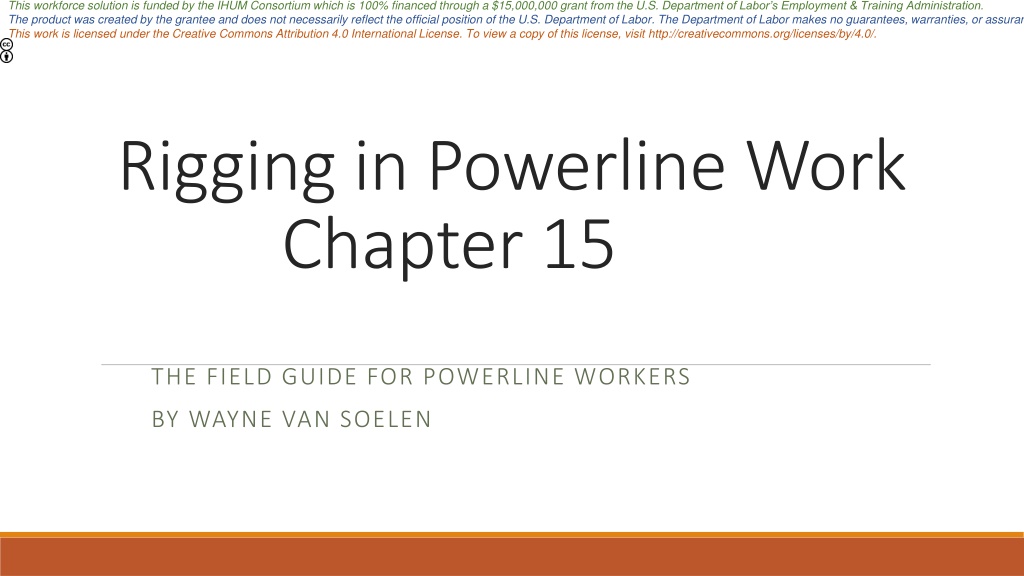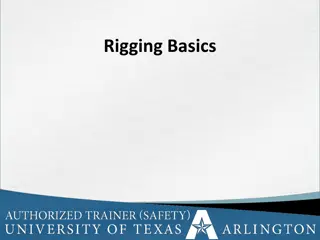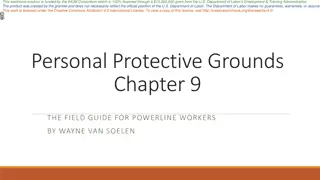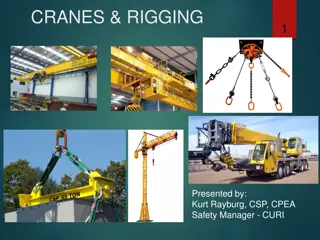Rigging Guidelines for Powerline Workers
This workforce solution, funded by the IHUM Consortium, provides essential guidelines on working load limits for rigging equipment such as fiber ropes, wire ropes, and chains. Understanding the maximum working load limit (WLL) is crucial to maintaining safety standards in powerline work. The guide explains how to calculate the WLL for different types of rigging materials and emphasizes the importance of proper usage to prevent equipment failure.
Download Presentation

Please find below an Image/Link to download the presentation.
The content on the website is provided AS IS for your information and personal use only. It may not be sold, licensed, or shared on other websites without obtaining consent from the author. Download presentation by click this link. If you encounter any issues during the download, it is possible that the publisher has removed the file from their server.
E N D
Presentation Transcript
This workforce solution is funded by the IHUM Consortium which is 100% financed through a $15,000,000 grant from the U.S. Department of Labors Employment & Training Administration. The product was created by the grantee and does not necessarily reflect the official position of the U.S. Department of Labor. The Department of Labor makes no guarantees, warranties, or assurances of any kind, express or implied, with respect to such i This work is licensed under the Creative Commons Attribution 4.0 International License. To view a copy of this license, visit http://creativecommons.org/licenses/by/4.0/. Rigging in Powerline Work Chapter 15 THE FIELD GUIDE FOR POWERLINE WORKERS BY WAYNE VAN SOELEN
15.1 Working Load Limits Working Load Limit (WLL) is the maximum working load designed by the manufacturer. This load represents a force that is much less than that required to make the lifting equipment fail or yield Each piece of rigging equipment must be labeled or identified by size (diameter) and checked against WLL tables The WLL must be known when working with: Rope blocks Hand lines Nylon slings Conductor grips
15.2.1 Fiber Rope The formula to find the WLL of inch polypropylene is as follows: Translate inch to eighths of an inch which is 4/8 Square the numerator 42 = 16 Multiply 16 by the rule-of-thumb factor of 40 16 x 40 = 640 The inch polypropylene has a WLL of 640 pounds There are also factors that can de-rate a rope, such as: 10% for an eye splice 45% for a bowline knot 60% for a square knot
15.2.2 Wire Rope The formula to find the WLL of 5/8 inch regular laid wire rope is as follows: 5/8 diameter has a denominator or 8 Square the numerator 52 = 25 Multiply 25 by the rule-of-thumb factor of 250 25 x 250 = 6,250 The 5/8 inch wire rope has a WLL of 6,250 pounds The figures below indicate the correct and incorrect way to use U-bolt clamps when making a temporary eye The u-bolts are spaced a distance equal to six times the diameter of the wire Correct Incorrect!!
15.2.3 Chains The formula to find the WLL of 3/8 inch alloy steel chain is as follows: 3/8 diameter already has a denominator expressed in eighths Square the numerator 32 = 9 Multiply 9 by the rule-of-thumb factor of 600 9 x 600 = 5,400 The 3/8 inch alloy steel chain has a WLL of 5,400 pounds Chain slings used for hoisting must not be used for any other purposes (a chain used for binding a load may have been subjected to shock loading)
15.2.4 Ratchet Chain Hoist Chain hoists required regularly scheduled maintenance The lower hook is the weakest part and can spread when overloaded Do not do any of the following when using chain hoists: Bind poles to a trailer Tie the chain into a knot/half hitch behind the anchor eye Overload the hoist by using a cheater bar Leave a chain hoist under tension for an extended period of time
15.2.5 Web Hoist Web hoists for work on or near energized lines and equipment should not be used for other work such as pulling down guys, service lines, etc. Web hoists should never be connected directly to a structure when attached to an energized conductor; an insulated link should always be used in instances such as this
15.2.6 Snatch Blocks A snatch block is a pulley block with a side plate that swings open. Because the side plate opens, you don't have to thread your winch cable through the opening, instead you open the side plate, fit the cable over the pulley, and then close the side plate
15.2.6 Snatch Block It is necessary to know the bisect tension that a snatch block will be holding, the WLL of the block and the WLL of the anchor point Following are some examples of the strain placed on a snatch block and anchor point: Lifting/pulling 1,000lbs with a bisect angle of 1350 Lifting/pulling 1,000lbs with a bisect angle of 900 Lifting/pulling 1,000lbs with a bisect angle of 450 Lifting/pulling 1,000lbs with a bisect angle of 00 760lbs of strain 1,410lbs of strain 1,840lbs of strain 2,000lbs of strain
15.2.7 Anchor Pulling Eye When pulling a down guy, the limiting factor could be the anchor pulling eye being used. The pulling eye shown below typically has a WLL of 3,000lbs ..but this can vary based on the type, etc. It is very easy to overload the pulling eye, grip or chain hoist when pulling on an existing down guy that is under tension.
15.2.8 Collapsible Bull (Butterfly)Wheel The WLL for a collapsible bull wheel is typically 4,000 lbs If an extension shaft is used the WLL is reduced to 800 lbs When taking up a rope under tension, the compressive force of a stretched rope can cause the bull wheel to collapse
15.2.9 Gins Gins used for line work are typically made of fiberglass and come in many types, shapes and sizes Gins are designed for working with vertical loads only Any side pulls or tagging out of a load will de-rate the WLL of the gin
15.2.10 Hand Line A hand line is a tool used to raise and lower material and tools to a person(s) working aloft either in a bucket truck or on their climbers Following are some items to remember regarding the proper use of a hand line: Keep the hand line away from traffic; be careful to not let the line blow into the roadway Never tie a hand line to a truck When climbing with a hand line attached to a body belt make certain the attachment point is capable of breaking away in the event it becomes snagged or caught Never directly hook a hand line to one of the tool loops on the body belt Keep the hand line away from the climber and their feet while ascending or descending a pole
15.2.11 Capstan Hoist Hazards and Facts A capstan hoist is a drum shaped device that is used for lifting vertical loads To control the weight to be lifted, the number of wraps around the drum should be such that 20 to 40 pounds of pull are exerted on the fall line One example is typically three turns are required to lift 600 lbs
15.2.12 Rope Blocks Rope blocks are a block and tackle system comprised of two or more pulleys with a rope threaded between them and are usually used to lift or pull heavy loads. The pulleys are assembled to form blocks and the blocks are paired so one is fixed and one moves with the load An example of the mechanical advantage of rope blocks a 1,000 pound transformer being lifted with a set of three sheave blocks will have a load of 267 pounds on the fall line
15.2.13 Sling Hazards and Facts The strength of a sling depends on its material strength and the manner it s hitched to the load A single-leg vertical sling with proper end fittings is rated at the strength of the rope (material strength) and the type of end fittings being used A tag line should be used when lifting loads that will have a tendency to swing or rotate. Allowing a load to rotate can result in a sling untwisting and weakening any hand-tucked eyes A single-wrap choker hitch is the weakest form of a hitch
15.2.13 Sling Hazards and Facts Types of hitches and their uses: A basket hitch should only be used on straight lifts A bridle hitch in intended to be a two-leg sling with two legs carrying the load A vertical hitch is when the sling is capable of lifting the most A choker hitch is the weakest type of hitch to use Note in Fig. 1 how changing the angle of the lifting eye de-rates the sling Fig. 1























